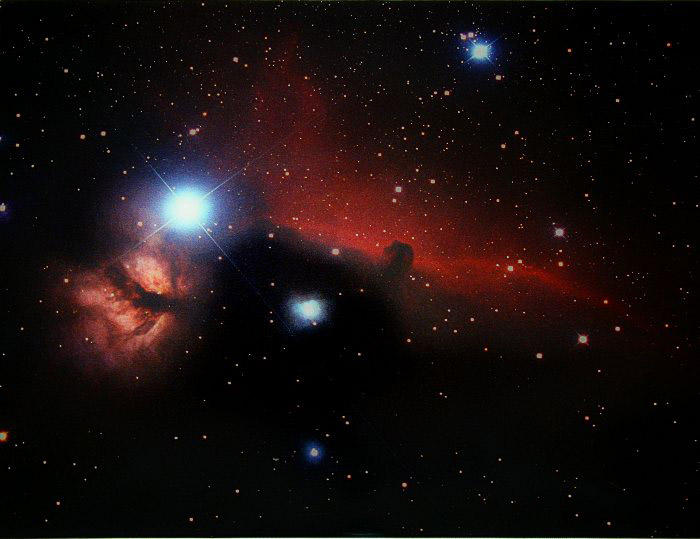
The brightest star in this photo is Zeta Orionis, also known as Alnitak. The region surrounding this star includes several nebulae. To the left of Zeta Orionis is the beautiful flame nebula, also known as NGC 2024. The long stretch of red nebulosity extending about a degree south of Zeta Orionis is known as IC 434, and measures about 18 light years long. The dark nebula obscuring part of IC 434 is the horsehead nebula, also known as B33. The horsehead nebula is a great obscuring cloud of dark matter that is a little more than a light year in diameter. The horsehead nebula is located about 1600 light years away. The horsehead nebula consists of carbonaceous dust grains no larger than the tiny particles that comprise cigarette smoke. The various nebulae shown in this photograph are almost completely invisible to the eye in a telescope, and require long exposure photographs to reveal them.
This photograph also shows the flame nebula NGC 2024 to the lower left of Zeta Orionis. The bright blue nebula to the right and below Zeta Orionis is NGC 2023. The spikes visible on the image of Zeta Orionis are artifacts known as diffraction spikes caused by the spider that supports the secondary mirror of the telescope used to take this photo.
This photo represents my first attempt at large format photography. The photograph was a 22 minute exposure taken with a Takahashi Epsilon 250 telescope at prime focus. The film was unhypered Kodak Pro 100 film. The exposure was guided with an ST-4 autoguider using a separate Takahashi FS-78 guidescope.
NGC2024.
Constellation: Orion
RA: 05h 41m 50.2s Dec: -01d 51' 01"
B33.
Constellation: Orion
RA: 05h 40m 56.1s Dec: -02d 24' 01"
November 11, 1998
Photo by Sid Leach
Iola, Texas
Recent Images.
Complete list of images.
Description of equipment used to acquire images.
Home
Feedback and comments should go to Sid